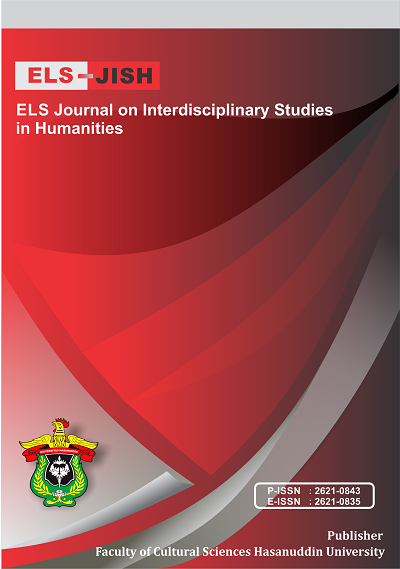Variety of Indonesian on Social Media
DOI:
https://doi.org/10.34050/elsjish.v6i1.25135Keywords:
Social Media, Twitter, Variety of LanguagesAbstract
Language is a communication tool used by the community to interact with great regiliat with a variety of languages. Variety of languages comes from two words, namely variety which means type, kind of, (indicating plural) and language, namely the sound symbol system used to communicate. Then it can be said that the variety of languages is kind, kind, and variations in language usage according to the context of use. The research conducted aims to find out how the variety of Indonesian language use on Twiter's social media, this research is a qualitative descriptive study, this study uses a type of research phenomology with a qualitative approach to the object of humans (human). Data from this study was obtained from a collection of several tweets from the @anyaLalubenar account and @dsuoerboy. The method of data collection in this study is observation and documentation. The results of this study are the discovery of some languages on @dupuperboy and @anyaLalubenar accounts but the variety of languages that are most often used from these two accounts on twiter social media, namely slang and code transfer and mixed code, but also found a variety of foreign languages.
References
Andini, C., Sosrohadi, S., Fairuz, F., Dalyan, M., Rahman, F. F., & Hasnia, H. (2022). The Study of Japanese Women in the Facial Treatment Advertisement: A Semiotics Perspective of Pierce’s Theory. ELS Journal on Interdisciplinary Studies in Humanities, 5(2), 337-347.
Agustina, S., & Nandiyanto, A. B. D. (2021). The effectiveness of distance learning using learning management system media and whatsapp groups at senior high school. Indonesian Journal of Multidiciplinary Research, 1(1), 89-98.
Baron, N. S. (2003). Language of the Internet. The Stanford handbook for language engineers, 59-127.
Bodker, S. (2021). Through the interface: A human activity approach to user interface design. CRC Press.
Chaer, A., & Agustina, L. (2004). Sosiolinguistik: perkenalan awal. In rev.jakarta:rineka cipta. https://doi.org/10.29303/jpft.v2i3.296
Coupland, N. and Adam. J. (1997). Sociolinguistics: A Reader and Coursebook. In England: Macmillan Press LTD.
Hasnia, H., Andini, C., Tahir, M. D., Hunaeni, H., Zulfikariandi, Z., & Muslimin, M. T. (2022). The Ability of 1st Class Students of SMAN 11 Enrekang to Arrange Verbal and Nominal Sentences. ELS Journal on Interdisciplinary Studies in Humanities, 5(3), 539-550.
Isnaniah, S., & Eliya, I. (2014). Sosiolinguistik Dalam Pengajaran Bahasa Berbasis Multikultural: Teori dan Praktik Penelitian. IN MEDIA.
Kridalaksa. (1984). Kamus Linguistik. Gramedia.
Mulyana, D. (2008). Bahasa Untuk Perguruan Tinggi. Rembang: Yayasan Adhigama.
Muysken, P. (2020). Code-switching and grammatical theory. In The bilingualism reader (pp. 280-297). Routledge.
Nahdhiyah, Rahman, F., Abas, H., & Pattu, M. A. (2023). Ecocritical study on relationships between humans, nature, and god in the novel the Alchemist. Cogent Arts & Humanities, 10(1), 2170019.
Nuralifa, Rahim, A. R., & Muhdina, D. (2021). Penggunaan Bahasa pada Media Sosial (Medsos): Studi Kajian Pragmatik. Gema Wiralodra, 12(2), 305–319.
Prayudi, S., & Nasution, W. (2020). Ragam Bahasa dalam Media Sosial Twitter: Kajian Sosiolinguistik. Jurnal Metamorfosa, 8(2), 269–280.
Rahman, F., Sutanto, T. E., & Fitriyati, N. (2021). Web Traffic Anomaly Detection using Stacked Long Short-Term Memory. InPrime: Indonesian Journal of Pure and Applied Mathematics, 3(2), 112-121.
Rahman, F., & Weda, S. (2019). Linguistic deviation and the rhetoric figures in Shakespeare’s selected plays. XLinguage" European Scientific Language Journal", 12(1), 37-52.
Richards, J., Platt, J. & Weber, H. (1985). Longman Dictionary of Applied Linguistics. Harlow: Longman.
Istiqomah, D. S., Istiqomah, D. S., & Nugraha, V. (2018). Analisis penggunaan bahasa prokem dalam media sosial. Parole (Jurnal Pendidikan Bahasa dan Sastra Indonesia), 1(5), 665-674.
Sakurai, R., Nemoto, Y., Mastunaga, H., & Fujiwara, Y. (2021). Who is mentally healthy? Mental health profiles of Japanese social networking service users with a focus on LINE, Facebook, Twitter, and Instagram. Plos one, 16(3), e0246090.
Surdayanto. (2013). Menguak Fungsi Hakiki Bangsa. Univercity Pers.
Uddin, M. Z. (2019). A wearable sensor-based activity prediction system to facilitate edge computing in smart healthcare system. Journal of Parallel and Distributed Computing, 123, 46-53.
Weda, S., Atmowardoyo, H., Rahman, F., & Sakti, A. E. F. (2021). Linguistic aspects in intercultural communication (IC) practices at a higher education institution in Indonesia. Eroupean Language Scientific Journal, 14, 2-6.
Wicaksono, H., Rahman,F., Sahib, H. (2021). Light Sign Communication Between Pilot and ATC: Language Function and Semiotics Analysis. American Journal of Humanities and Social Sciences Research, 5(11), 176-185
Wiratno, T., & Santosa, R. (2014). Bahasa, fungsi bahasa, dan konteks sosial. Modul Pengantar Linguistik Umum, 1-19.
Downloads
Published
How to Cite
Issue
Section
License
Copyright (c) 2023 Muh. Ishar, Laeli Qadrianti, Ulfayanti, Harmilawati

This work is licensed under a Creative Commons Attribution-ShareAlike 4.0 International License.






